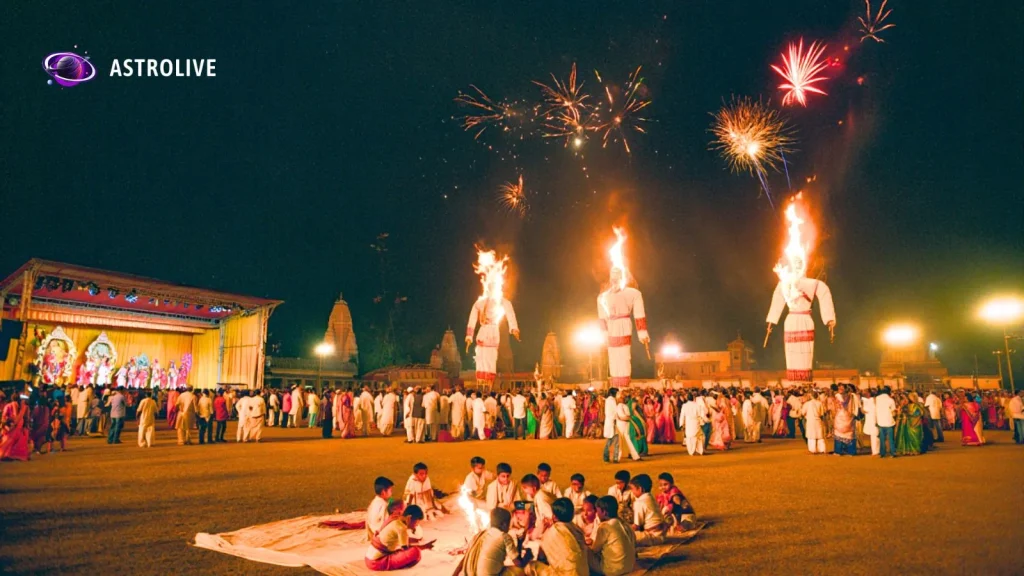Every year, as the autumn breeze sets in and festive lights begin to glow, Dussehra arrives with a sense of joy and anticipation. Streets fill with the excitement of Ramlila performances, families gather for puja, and towering effigies of Ravana stand ready to be set ablaze. At first glance, Dussehra might look like just another grand Indian festival, but its roots go far deeper.
Known as Vijayadashami in many parts of the country, this day celebrates the ultimate triumph of good over evil. It’s not just about remembering the victory of Lord Rama over Ravana or Goddess Durga’s conquest of Mahishasura; it’s about carrying those lessons into our own lives. Beyond the rituals, fairs, and celebrations, Dussehra holds powerful spiritual and cultural meaning that continues to inspire generations.
This blog explores why Dussehra is much more than a festival; it’s a timeless reminder of resilience, positivity, and unity.
What is Dussehra?
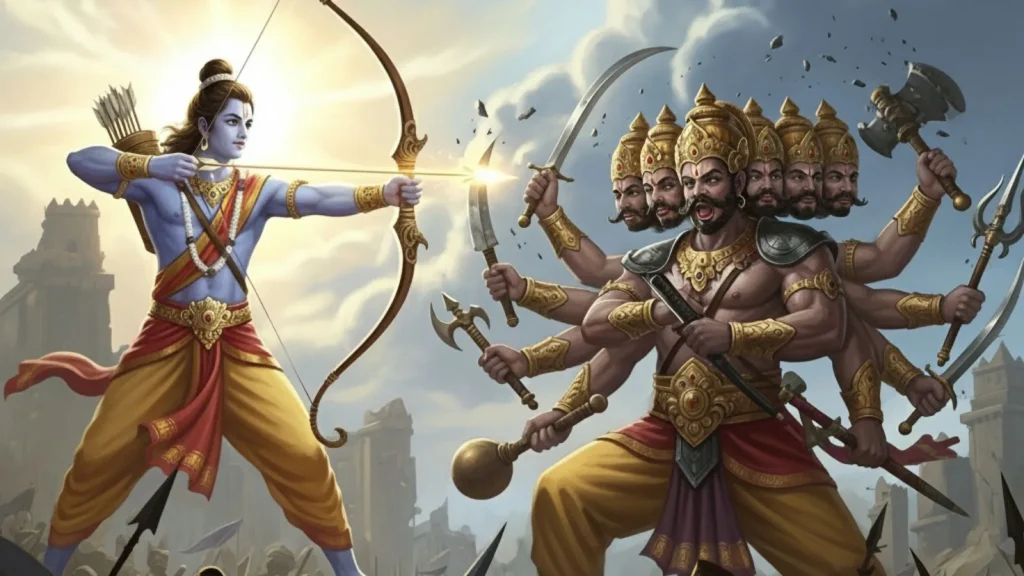
Dussehra, also called Vijay Dashmi or विजयादशमी, is one of the most celebrated Hindu festivals across India. The name itself carries deep meaning. “Dussehra” comes from the Sanskrit words dasha (ten) and hara (defeat), symbolizing the defeat of the ten-headed demon king Ravana by Lord Rama. Vijayadashami means ‘tenth day of victory’ and marks the end of the nine-day Navratri festival.
This day is associated with two major legends. In the North, it is remembered as the day Lord Rama defeated Ravana and rescued Sita, highlighting the triumph of truth and righteousness. In the East, it coincides with the celebration of Goddess Durga’s victory over the demon Mahishasura, representing the power of divine energy against evil forces.
Because of its dual significance, Dussehra isn’t just a ritualistic holiday; it’s a cultural and spiritual celebration reminding people that no matter how strong evil seems, truth and virtue will always prevail.
Also Read,
How To Celebrate Dhanteras 2025 For Wealth And Prosperity?
The Mythological Significance
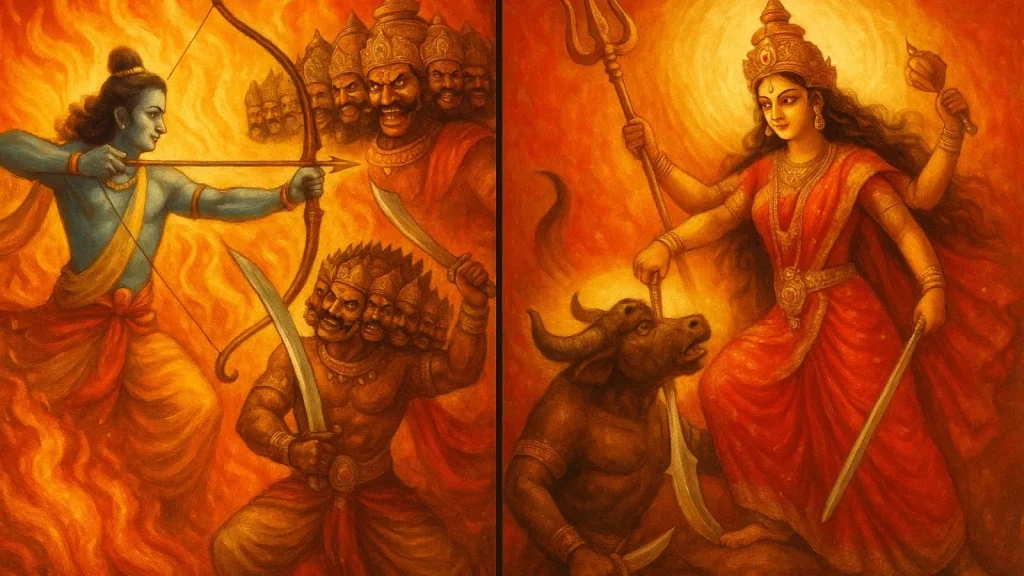
The stories linked with Dussehra are among the most powerful lessons in Indian mythology. The first and most popular is from the Ramayana, where Lord Rama, with the blessings of Goddess Durga, defeats the mighty Ravana. Ravana, though brilliant and powerful, symbolized arrogance and ego, while Rama stood for righteousness, truth, and devotion. The burning of Ravana’s effigies on Dussehra is not just a spectacle; it represents the destruction of pride, greed, and negative qualities that can take root in all of us.
In another legend, this day marks the victory of Goddess Durga over the demon Mahishasura after a fierce nine-day battle. This form of Vijayadashami reminds us of the strength of divine feminine power and the importance of courage in overcoming darkness.
Both stories highlight the same truth: good will always triumph over evil. The real power of Dussehra lies in its message that these battles are not just stories from the past, but symbolic of the struggles we face within ourselves—battles against ego, negativity, and fear.
Dussehra 2025 Date and Timings
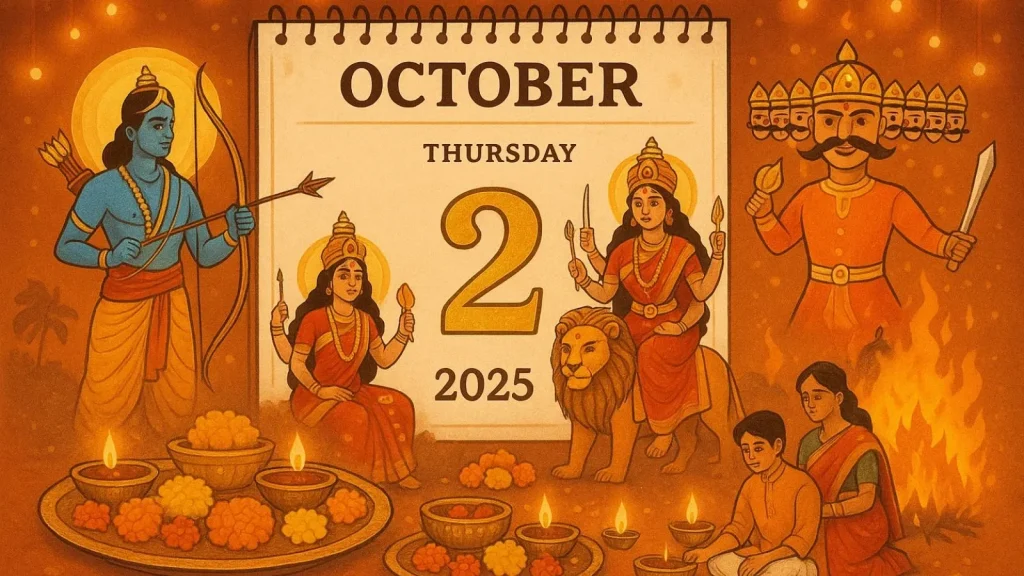
One of the most awaited aspects of this festival is knowing the exact Dussehra 2025 date and the auspicious timings for rituals. In 2025, Dussehra or Vijayadashami 2025 will be celebrated on Tuesday, October 2, 2025.
The festival falls on the Dashami Tithi (tenth day) of the Shukla Paksha in the Hindu month of Ashwin. Devotees often check Dashara kab hai and the exact Vijayadashami 2025 date in the Hindu calendar to perform rituals at the right muhurat. Performing puja and other ceremonies at the correct timing is believed to invite prosperity, peace, and spiritual strength into one’s life.
On this day, people worship Lord Rama, Goddess Durga, and even their tools, books, and vehicles, believing it to be an auspicious time to start new ventures or endeavors. For many, Vijayadashami isn’t just about celebration; it’s also considered a highly spiritual day for seeking blessings and embracing new beginnings.
Also Read,
How To Celebrate Durga Ashtami For Maximum Blessings?
Cultural and Regional Celebrations
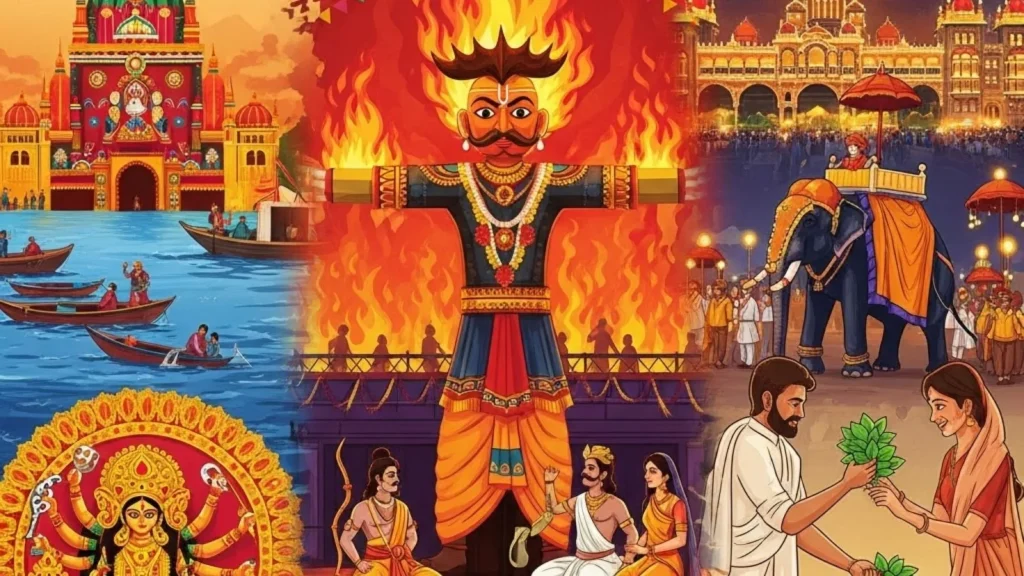
One of the most beautiful aspects of Dussehra is how it’s celebrated differently across India, yet always with the same core message: the victory of good over evil.
In North India, Dussehra is marked by grand Ramlila performances, where episodes from the Ramayana are enacted over several days, leading to the symbolic burning of Ravana, Meghnath, and Kumbhkaran effigies. These celebrations are not just entertainment but also a way to pass down moral lessons to younger generations.
In West Bengal and Eastern states, Vijayadashami signals the end of Durga Puja. Devotees bid farewell to Goddess Durga with great emotion during the Visarjan (immersion of idols), symbolizing her return to Mount Kailash.
In Mysore (Karnataka), the festival is celebrated with royal grandeur. The Mysore Palace is illuminated, and a majestic procession featuring the idol of Goddess Chamundeshwari atop a decorated elephant draws massive crowds.
In Maharashtra, families observe the tradition of exchanging Apta leaves, symbolizing gold, as a gesture of goodwill and prosperity.
From the heartlands of Uttar Pradesh to the cultural streets of Bengal and the royal lanes of Mysore, Dussehra unites the country through diverse traditions while keeping its spiritual essence intact.
Spiritual Lessons From Dussehra
At its heart, Dussehra is more than a celebration of ancient victories—it’s a festival that invites reflection on our own lives. The stories of Lord Rama and Goddess Durga remind us that the real battles are often within us.
- Victory of good over evil: Just as Ravana’s arrogance and Mahishasura’s tyranny were destroyed, Dussehra urges us to overcome our inner negativity, ego, and destructive habits.
- Courage in adversity: Both Rama and Durga fought against mighty odds, teaching us the value of patience, faith, and resilience in the face of life’s struggles.
- Moral integrity: Rama’s devotion to truth and righteousness stands as a timeless reminder that values and ethics matter, even in difficult times.
These lessons make Dussehra more than just a cultural holiday; it’s a guide to leading a more meaningful, balanced life. By remembering its message, we’re reminded to choose kindness, truth, and positivity every day.
Modern Relevance of Dussehra
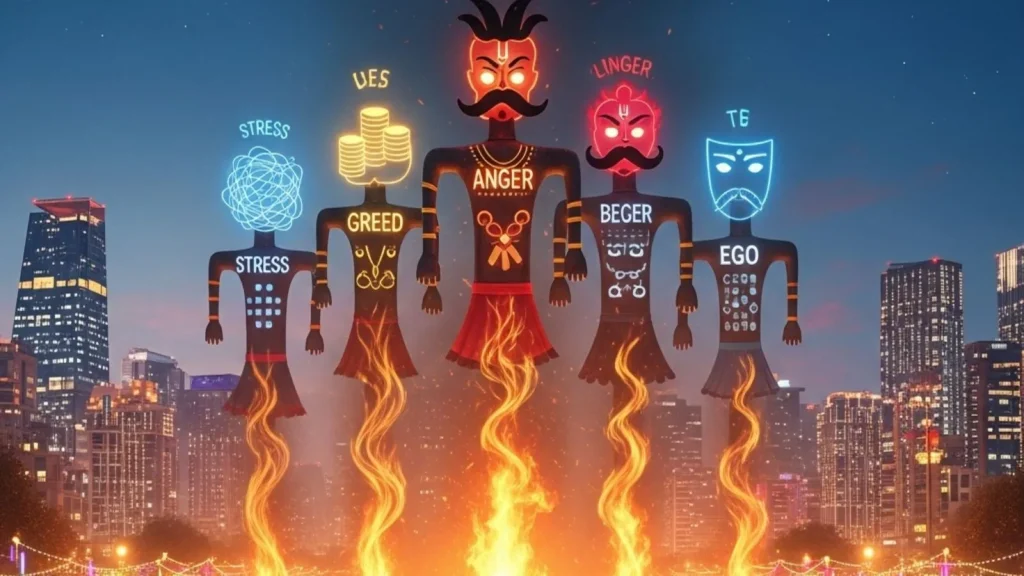
Even though Dussehra is rooted in mythology, its relevance in today’s world is undeniable. The festival’s message isn’t just about burning effigies or performing rituals—it’s about applying those lessons in our daily lives.
In the modern context, Ravana’s ten heads can be seen as symbols of challenges like stress, greed, anger, jealousy, and ego that we all face. Dussehra encourages us to conquer these inner struggles and live with clarity and balance.
It’s also a festival that strengthens community bonds. Families come together, neighborhoods organize celebrations, and entire cities light up with joy. In a time where busy schedules often leave little room for connection, Dussehra offers a chance to pause, reflect, and unite with loved ones.
For many, it’s also a reminder of new beginnings. Starting a business, buying a new vehicle, or beginning fresh endeavors on Vijayadashami is believed to bring success and prosperity. In this way, Dussehra continues to guide both spiritual reflection and practical life choices, making it more relevant than ever.
Also read,
Everything You Need To Know About Navratri: A Cultural Journey
Track the Auspicious With AstroLive

Festivals like Dussehra carry deep spiritual value, and many families prefer to perform rituals at the most auspicious time. That’s where AstroLive becomes your trusted guide. With accurate insights into muhurat, puja vidhi, and personalized rituals, AstroLive helps you celebrate Dussehra with clarity and confidence.
Instead of searching multiple sources for Dashara kab hai or the right Vijayadashami 2025 date, you can rely on AstroLive for authentic details directly from experts. Whether it’s guidance on prayers for Lord Rama, the immersion rituals of Goddess Durga, or the best time to begin new ventures, AstroLive ensures you never miss the spiritual essence of the day.
By combining tradition with technology, AstroLive makes it easier to stay connected to your roots while embracing modern convenience. This Dussehra, let AstroLive be your companion in celebrating the victory of light, positivity, and new beginnings.

Conclusion
Dussehra, or Vijayadashami, is more than a festival marked by grand celebrations and rituals. It is a reminder that truth, courage, and goodness will always rise above negativity and darkness. From the epic battles of Lord Rama and Goddess Durga to the diverse traditions celebrated across India, the festival carries timeless messages that are still relevant today.
As families gather, effigies burn, and prayers are offered, Dussehra calls us to look inward and conquer the Ravana within our pride, anger, and doubts. It’s also a chance to celebrate unity, strengthen bonds, and embrace new beginnings with hope and positivity.
This year, let Dussehra be more than a date on the calendar. Let it inspire you to carry its spirit into your daily life, choosing kindness, standing for truth, and spreading light wherever you go.
FAQ’s
1. What is the significance of Dussehra (Vijayadashami)?
Dussehra, also called Vijayadashami, celebrates the victory of good over evil. It marks Lord Rama’s triumph over Ravana in the Ramayana and Goddess Durga’s victory over the demon Mahishasura. Beyond the myths, it symbolizes courage, moral integrity, and the triumph of righteousness in our daily lives.
2. When is Dussehra 2025, and how is it celebrated?
In 2025, Dussehra or Vijayadashami falls on Tuesday, October 2. The festival is celebrated with Ramlila performances, the burning of Ravana effigies, Durga Puja Visarjan in the East, and regional traditions like Mysore’s royal procession or Maharashtra’s Apta leaf exchange. Devotees also perform rituals at auspicious timings to invite prosperity and new beginnings.
3. How can I observe the spiritual lessons of Dussehra in daily life?
Dussehra encourages self-reflection and inner growth. By overcoming ego, negativity, and destructive habits (symbolized by Ravana’s ten heads), practicing courage like Rama and Durga, and maintaining moral integrity, we can apply the festival’s lessons to daily challenges. It’s also a reminder to foster unity, kindness, and positivity in relationships and communities.


